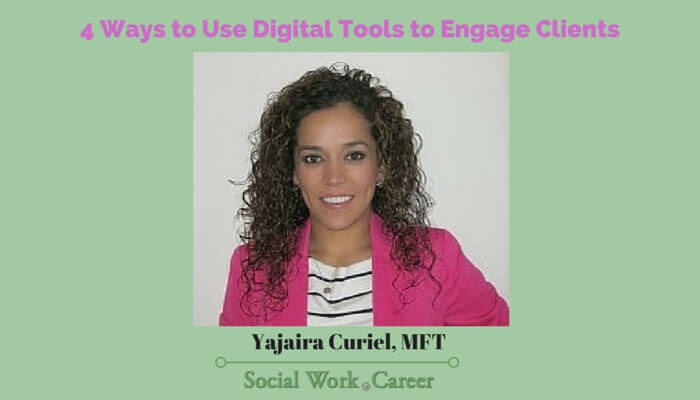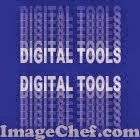Are you looking for some innovative ways to connect with your clients?
You might want to consider employing technology to facilitate engagement with some of your clients.
Yajaira Curiel, MFT shared some simple low-tech illustrations of how she has done this in her practice at a presentation she gave called “Digital Tools for Healing.”
Case Scenario: One teen client was depressed and not interested in talking but would come in with her ipod and headphones listening to music.
Technology Solution: “2 way splitter” to allow both therapist and client to listen together to client’s music
Yajaira asked if she could listen with her client to one of her songs on her next visit.
This simple move opened the channels of communication. The song the client chose to share with her was very significant and this enabled the therapist to ask her client what the song meant to her, what were the experiences she had with it etc.
Listening to songs has remained part of the way they communicate with one another in session. Thanks to this adjustment/accommodation on her part, Yajaira succeeded in helping the client not only open up but make significant progress in her therapy. The client is no longer depressed or homeless but enrolled in a community college.
Case Scenario: There was a female client who wanted to be able to reach out to her mother for emotional support but was at a loss of how to do this because there was a lot of emotional baggage/history that had to be aired out between them.
To help her client move forward, Yajaira wanted her client to fulfill a homework assignment in which she would share her grievances in a journal but her client was unable to do so because she was not a “pen and paper” type of person.
Technology Solution: Cellphone as an audio journal recorder [via bluetooth]
Yajaira proposed to her client to record her response using her cellphone. This idea appealed to her client but time was an issue so they came up with the plan where she would record her response en route to work using Bluetooth to ensure her safety as she was driving to work and fulfilling this assignment.
This method enabled this woman to provide 2 journal entries, These, in turn, gave them good material to work on together in subsequent sessions which ultimately led to a session with the client’s mother. All this progress was possible thanks to the flexibility Yajaira demonstrated regarding the journal modality.
High Conflict Couple: Yajaira didn’t actually provide a specific case of a high conflict couple but rather described how often with couples who are quarreling, both the husband and wife or the partners will have difficulty in finding a moment of compassion for one another, for how things used to be.
Technology Solution: Soundtrack/album of songs and pictures
Under such a scenario, she will typically ask them to make a soundtrack of their relationship – to think and choose the songs to reflect on a time when things used to be better [how things used to be at the beginning, when things were positive]. Similarly, she will ask them to select the pictures that would best represent that time period.
These types of activities are very effective at helping them slow down, reflect and see what was good in their relationship.
Scapegoating: No specific example of scapegoating was presented but the problem of rigidity in how we see people or things was raised and how this may be an impediment to a client or family moving forward in therapy.
Technology Solution: Viewing of a relevant youtube video
Above is an example of one of the videos Yajaira has used for this purpose. It is called “The danger of a single story.”
It is a very moving TED talk that demonstrates the power of a single story. As Chimamanda Adichie explains so eloquently, the problem with stereotypes is that they are incomplete; they only tell part of the story. They emphasize how we are different rather than how we are similar. It is truly a talk that is worth listening to…
Watching this youtube video [or another one] can be a gentle way of opening up a discussion on a topic such as scapegoating, racism, oppression and more.
In closing, I will just share that as per Yajaira, we are currently in the midst of 2 revolutions:
1) a technology revolution
2) a cultural revolution
The technology revolution refers to the fact that everything is quick and continually being made faster and briefer. This speed is also impacting our social interactions. Even our language has changed to accommodate technology’s requirements such as LOL and BRB.
The cultural revolution is about the “browning of America” or the growing diversity, forcing us to re-evaluate various outdated policies such as those around immigration and gay rights.
These two revolutions are at odds with one another; the technology revolution is all about racing around while the cultural revolution is about slowing down and spending time with people.
Our work is in bridging both these two paradigms; we’re not either or; we need to effectively engage in technology in our everyday lives and practice.
For some additional tech variations of engagement with clients, please see Got clients? Learn about cyberculture! , How To Start Up a Private Practice in which Mike Langlois discusses his gamer affirmative orientation and Online Therapy: A New Frontier.
What other ways can you think of that digital tools may be used to engage clients? And/or what other technology do you think may be helpful ?
Reference: Curiel, Yajaira. (2013). “Digital Tools for Healing.” Psychotherapy Networker Symposium




I love the two way splitter idea for working with teens!! Thanks for this article!
Hi Mercedes,
Thanks so much for stopping by. I’m so glad that you enjoyed this article. I too loved the two way splitter idea; it’s a creative way of meeting our teen clients where they are and so many of them are into music 🙂
Best,
Dorlee
Hello Dorlee,
Someone with wisdom said: “Meet them where they are”.
And so it makes sense that for those clients where technology is an integral part of their lives, utilizing technology to reach out to them and for them to use for their exploration and growth would be impactful.
One tool to consider is social media. Used with proper safeguards, social media can be enlightening. In the case of a client wanting to invite more gratitude into life, sharing gratitude on social media sites like Pinterest, Instagram, Twitter might resonate with the additional benefit of finding a like-minded community for support.
The ideas in your post are straightforward and practical — thanks for sharing!
Jackie Yun
Dorlee,
The idea of using a splitter to share in music is so intriguing! Because of the transportive nature of music, this idea just really captured my attention. Love it. Certain lyrics or melodies can calm, energize or express our feelings in such a unique way. I think your mentioning the therapist implementing this with a patient is helpful, and it extends beyond to other relationships, where bonding through music can be bolstering.
I also like the idea of soundtrack of songs/pictures for couples. And my thoughts meld a bit with what Jackie says in regards to social media. Because my husband, Rob, and I maintain a robust album of photos on Facebook, we find ourselves reminiscing from time to time through those photos. Helps to reflect on the many good times, especially during times of stress or other pressures.
Thanks again for another great interview! I certainly enjoyed Yajaira Curiel’s insights on using digital tools for healing!
Jacqui
Hi Jackie,
Yes, you hit the nail on the head with our need to meet our clients where they are and if technology is an integral part of our clients lives, we should take advantage of this tool as a potential engagement tool.
Thank you for suggesting the use of social media [with proper safeguards] as one potential avenue from which clients may find a supportive community.
I also like your idea of encouraging clients to “invite more gratitude into life.” This is an intervention that has been proven to increase one’s mental and physical well-being.
You are so kind to have stopped by to share your ideas!
Hi Jacqui,
Thanks so much for sharing your thoughts and reactions to the ideas presented here. I’m so glad that idea of bonding via music and photos resonated with you.
In some of my prior posts on this topic, other therapists shared the importance of being aware of cyberculture, gaming, and the various forms of social media.
This presentation was the first one I had heard in which simple low tech ideas were presented and they make total intuitive sense 🙂
How wonderful that you and Rob take the time to periodically look through past photos as a way of bonding and remembering previous fun/enjoyable experiences you’ve shared. That is such a wonderful way of both relaxing and further strengthening your special relationship.
Thanks so much for sharing!
Hi Dorlee,
One of the things that was drilled into us as teachers was that students have multiple intelligences, thus it is extremely important to address the needs of the students by presenting lessons in a variety of ways that captivates and engages the diverse learning styles. This does not stop at the classroom doors.
I particularly enjoyed the creativity and the innovation that Yajaira demonstrates as she “meets her clients where they are”.
Sometimes, in the case of a rocky relationship, a voice can trigger the stress response, damming the channels of communication, such as in the mother-daughter case study. I have successfully used letters, and now email, to build a communication bridge.
Even though Marshall McLuhan was referring to the technology available in the 1960’s, I think it applies today.He is well-known for stating that the medium is the message. He goes on to say, “It is not the content or use of the innovation, but the change in inter-personal dynamics that the innovation brings with it.” (http://individual.utoronto.ca/markfederman/article_mediumisthemessage.htm)
Technology changes us – for bad or good. Developing healthy habits around the use of technology, and its effects is important for our health, not only individually, and also, culturally.
Thank you for this insightful interview.
Warmly,
Marianna Paulson
Hi Marianna,
Thank you so much for sharing your valuable experiences and knowledge from your teaching background. How interesting that you’ve employed letters and emails to help others forge communications between their estranged relatives.
I love how you’ve extended the ideas Yajaira made in her presentation [I’m afraid I cannot claim any credit for an interview; I only took notes :)].
Marshall McLuhan’s work looks fascinating. In reading the link, I see how he also views a medium as “an extension of ourselves.” This too supports the idea that when working with others, we make sure to take into account all the mediums they consider extensions of self and include them in the therapeutic conversation…
Thanks again,
Warmly,
Dorlee